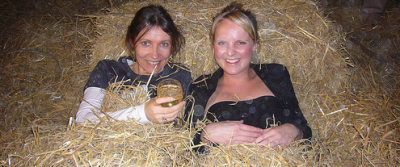The army unit I served in (way back when) was featured in tonight’s news broadcast for having cancer levels more than twice as high as other infantry units. Channel 2 TV (Arutz 2) reported this evening (video, in Hebrew) that IDF’s Nachal infantry had 2.5 as many Hodgkin’s Lymphoma cases than either Paratroopers or Golani, the two main “competitor” infantry units. This raised echoes of an earlier cancer cluster in the Navy Seal commandos who trained in the polluted Kishon River.
Levels of Cancer: According to the report, the army medical corps ignored reports from casualty officers about cancer cases in the unit for 8 years, declaring that the data was insufficient and not deserving of comments. An investigation was begun only in the past few months, including the IDF, the Health Ministry, and a group of independent expert consultants. The results?
Lymphoma cancer cases in the Nachal were 2.5 times higher than in other infantry units, a statistically significant difference, and all types of cancers were also higher in this unit, according to Micha Bar Chana, the chief cancer scientist in the Health Ministry.
How much higher? Among soldiers – warriors in top physical condition – who served between 1994 and 2004, lymphoma cases were
7 among paratrooper and Golani soldiers
17 among the Nachal soldiers, 2.5 times greater.
For all forms of cancer, there were 58 cases in the Nachal, compared with 43 cases in Golani and 47 among paratroopers.
The challenge in dealing with comparing the occurrence of cancer is that the disease is rare in populations, so we have to deal with statistics of small and highly variable numbers. In this case, however, there is widespread agreement that
(1) this collection of cases is significantly higher than in comparable groups of infantry soldiers from similar backgrounds and life experiences, and
(2) the situation requires further investigation into the causes.
Possible Causes: Hodgkin’s Lymphoma can be caused (according to Professor Elihu Richter of Hebrew University’s School of Public Health) by environmental exposure to
(1)organophosphoric pesticides
(2)organic solvents
(3)radiation of various types
(4)viruses
It seems imperative to figure out what might have caused the cancer cluster among Nachal soldiers. To do so, we have to look at the differences between Nachal service and other infantry units, and a possible link to the risk factors listed above.
One major difference between the units is the base where they do basic training, and this would be a natural place to start investigating environmental causes of cancer. The Nachal base is located near Tel Arad, 25 km east of Beer Sheva, and 40 km northeast of the petrochemical factory and industrial waste area of Ramat Hovav.
area map of training base (A), Beer Sheva (B) , Ramat Hovav (C)
The base is adjacent to the Arad municipal sewage treatment ponds, which get sewage from the Arad industrial area. From the map it is evident that the overflow from the ponds passes in the wadi (dry riverbed) just below the base.
local map of training base to the north of the sewage ponds
The (Questionable) Linkage: Now the channel 2 reporter starts to get creative: The municipal sewage ponds also include effluent from the industrial area, where some factories produce pesticides. The army, they state, did not bother to check what was sent into the ponds, nor did it check what is in the sewage that flows towards the base. Then they go a step further and check for themselves: the reporter (not a certified sampler) is shown taking water samples from the pond and soil samples from the area (and, I should mention, in containers that cannot be used for analysis of organic solvents). The horrifying conclusion? Lab tests showed no violations of standards for pesticides or organic solvents – in other words, no indication of danger or risk.
However, they state, in the past there have been reports from the Environment Ministry of discharge violations from the factories in the industrial area, some of them into the sewage ponds. The details were not disclosed due to considerations of trade secrets.
The IDF’s Response: The chief medical officer of the army responded in a recorded interview, stating that the army was looking into the possibility that there is a real Hodgkin’s disease cluster connected to the Nachal base, assisted by top experts including the Ministry of Health. They are in the midst of exploring any connection to factors, environmental or otherwise, and so far have not found any link. Finally, the officer emphasized that there is no basis to worry the public at this point, and that we should wait until the tests are finished
Exposure Analysis: Channel 2 is correct in claiming that the army took a long time to recognize the elevated levels of disease. However, they are jumping the gun in appearing to claim that they have found the source of the disease in the sewage ponds. Notice that they didn’t show a smoking gun – far from it. They pointed at a possible source, took one measurement that showed that there was nothing there, and claimed that the Army had not looked into it. The chance of problematic exposure of pesticides from the ponds is possible but, in my opinion, unlikely, since pesticides do not spread through the air and are now designed to break down quickly in the environment. It is also unlikely, although it is possible, that the soldiers were rolling around in sewage mud that might theoretically have contained pesticides.
To summarize: the situation is much more complicated than the “obvious” solution raised by Channel 2, and jumping to conclusions is not productive. All possibilities must be considered and tested, and that process cannot be rushed – but Channel 2 is absolutely correct that it cannot be ignored, and their pressure on the Army is certainly a positive influence.
In the Kishon Disaster, it was impossible to prove a scientific connection between the exposure in the river to the disease. Even so, the judge and the Army agreed to recognize the affected soldiers as injured during duty, and to compensate them. The serious health concerns must be taken in the context of the Kishon affair, and the plans to build a huge Army Base City 10 km from the highly hazardous Ramat Hovav area. It is definitely possible that the cause of the apparent cluster will not be proven, due to our lack of knowledge about the connection between these diseases and exposure to environmental hazards.
The soldiers face enough hazards serving the country that they should not face preventable additional risks, and it is imperative to get to the bottom of this. According to the report, the IDF is taking this seriously and working with the most qualified people in the field.
Links:
Photo: wikimedia commons, IDF
Maps: Google Earth
Channel 2 News report (Hebrew)




I served in the Nahal (931) from 1995. I too, trained in Arad and also was taken seriously ill, with dozens of other troops, after the water supply, had apparently been contaminated.The symptoms, were diarrhea, fever and vomiting. Many of the cases were mild but a few, including myself, needed further medical treatment.I went on to develop reactive arthritis and was on 'gimmelin', for several months after my 'emoon-mitkadem'.I was diagnosed five years ago with Ankylosing Spondylitis, which I'm doubtful, is the whole story of my illness.
I served in the Nahal (931) from 1995. I too, trained in Arad and also was taken seriously ill, with dozens of other troops, after the water supply, had apparently been contaminated.The symptoms, were diarrhea, fever and vomiting. Many of the cases were mild but a few, including myself, needed further medical treatment.I went on to develop reactive arthritis and was on 'gimmelin', for several months after my 'emoon-mitkadem'.I was diagnosed five years ago with Ankylosing Spondylitis, which I'm doubtful, is the whole story of my illness.
עד מתי נוב 98!?